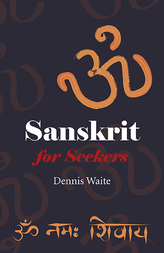Sanskrit is an extremely interesting language. It is amazingly logical. There are lots of rules but, once you have learnt them, there are none of the tiresome exceptions found in most languages. Also, once you have learned how to pronounce a letter, it is always pronounced in that way. Unfortunately, simply learning the letters is not sufficient to enable you to look up words in the dictionary. Letter combinations can look quite different from the same letters on their own. Also words found in the scriptures usually consist of combinations of many separate words and, when words join, they often change. An example that you will probably have seen is sachchidAnanda. If you did not know this word, you would have to know the rules of these combinations in order to be able to work out that the separate words of which this consists - sat, chit and Ananda - in order to be able to look them up. You can see that, when a word ending in t combines with one beginning with ch, the t also changes to a ch. And the t at the end of chit becomes a d. Accordingly, you will not find this word in the dictionary under 'sach' but just after 'sat'. This particular word is present in its complete form because it is in such common usage but infrequent combinations will not themselves be listed and you have to break them down into the individual words to find out the meaning. (This is known as euphony or 'sandhi'.)
Sanskrit uses an alphabet quite unlike ours. For a start, it contains nearly twice as many letters (more than three times the number of vowels) and these letters can look quite different depending upon where they appear in a word and which other letters are adjacent. The language is also written in 'Devanagari' script, which is quite unreadable without a lot of study and practice. Here is an example:

It is one of the mahavakyas, the four aphorisms from the Vedas. This one is tat tvam asi - perhaps the most famous - and means 'thou art that', i.e. you are the one unchanging reality, the Self, Brahman or God.
It is interesting to note in passing that there is a close parallel between the structure of the language and the Advaita-related myth of the creation. Indeed, some schools of thought, notably in the North of India and Kashmir, believe that the universe was 'spoken' into existence. Though this 'primordial' language is beyond ordinary sound, Sanskrit is its earthly manifestation as it were and embodies many of the 'universal principles'. The language itself is believed to embody the truth of the unity of the Self. Since pure Advaita claims that there is effectively no such thing as creation, the value of discussing these ideas is ultimately academic. Such studies can help prepare the mind to acknowledge those truths that remain forever beyond its grasp but they can also prove a hindrance. They have more appeal to those whose nature is inclined towards bhakti yoga rather than j~nAna. The entire language evolves in an almost mathematical way from a fundamental sound. The laws governing the way that words are constructed, and the grammar used to join them, are strict. It is amazing that the language, though the most ancient known and no longer in general use, remains true to its original form and someone learning it now would be able to communicate perfectly well with someone speaking the language thousands of years ago.

I wrote this book for people who were in the position I had been several years earlier of wanting to be able to 'read' the Devanagari script in Upanishads and the Gita and look up some of the words in a dictionary. It also seemed useful (it was an inevitable part of satisfying the first requirement anyway!) to be able to pronounce and write them correctly.
It provides a two-level introduction to the Sanskrit language. Level one introduces the transliterated (Anglicised) alphabets used by books and the Internet for reproducing Sanskrit. Level two teaches the Devanagari script used for the true language and describes the main rules for combining letters and words. Correct pronunciation and writing are explained. The shivasUtrANi are explained in passing and some of the rules from the laghu-siddhAnta-kaumudI but this should not put anyone off since the whole exposition is intended for a complete beginner. A number of examples from the Upanishads, Gita and Astavakra Gita are used to illustrate simple translation. There is a comprehensive glossary of the Sanskrit terms used and a second one containing commonly encountered spiritual words. Extracts from the book can be seen here.
****************
N.B. In order to be able to view the Devanagari script on the other pages of this section, you will need to have the appropriate Sanskrit font installed on your computer.
Look at this table:
If the character in the right hand cell looks like the picture in the left hand cell then you already have the font installed. Otherwise, follow the instructions below.
Download the 'Sanskrit99' font. The file downloads as a 'zip' file. Use Winzip or other program to extract the file Sanskrit99.ttf. Then, with a computer running MS Windows, select the 'Fonts' program from the Control Panel. Then select, 'File, Install New Font' and select the 'ttf' file just downloaded. The font will be installed and the Devanagari script will then be visible. |









